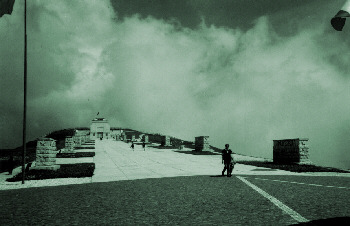
STOP XVI

|
Monte |
No battle defines Italy's struggle in la Grande Guerra better than Monte Grappa. Not only is it a tactical, political and morale watershed for the Italian military and people, the combat on the Grappa massif was also one of the greatest, unsung battles of World War One. The preliminary phase of what finished at Monte Grappa, the Twelfth Battle of the Isonzo or Caporetto, usually involves a paragraph in average history texts but the incredible conclusion, Italy's vindication if not survival, does not seem to fit in with the commonly told story. It is not history alone however, that tells the greatest story of Monte Grappa. The physical reality of this great mountain, viewed from the plains below or atop the summit, intensifies the story of the Italian Army's desperate courage and last stand in late 1917 and how incredibly close the combined Austrian and German armies came to total victory. The tomb of 25,000 Italian and Austrian warriors on its very summit bear mute witness to the armed struggle atop Monte Grappa -- often called "Italy's Thermopylae."
 During the War Mte Grappa in DistanceThe 14th to 17th of December 1917 witnessed the supreme attack of the German Alpenkorps -- to take the central Valle de Mure and control the summit of Monte Grappa. The Italian Ravenna, Umbria and Campania regiments, as well as several Alpini battalions and their manpacked light artillery pieces did battle with three German Jager regiments and their famed mountain brigade. The Italian defenses were finally wearing the Austro-German onslaught down. On the 23rd of December Italy's greatest ally, winter, arrived one month late. Warfare in deep snow cost the attacking Germans dearly. In the Wurttemberg Mountain Brigade, many companies, including that of First Lieutenant Erwin Rommel, were reduced to twenty-five men. On the 28th of December, Monte Asolone and Col della Beretta were recaptured by the troops of Abruzzi Brigade and Alpini of the Monte Rosa, Susa and Pinerolo Battalions. The end of combat on Monte Grappa, and the conclusion of this "arresting" battle, was the recapture of Monte Tomba on the 30th of December by the French 47th division of Chasseurs Alpins. In half an hour over 500 Austrians were killed, with three times as many captured. The Allied dead numbered 47 French and 4 Italians. German and Austrian forces now retreated to the immediate ridgelines north of Asolone, Pertica and Tomba for the duration of the winter.  Atop Mte Grappa Today |
|


